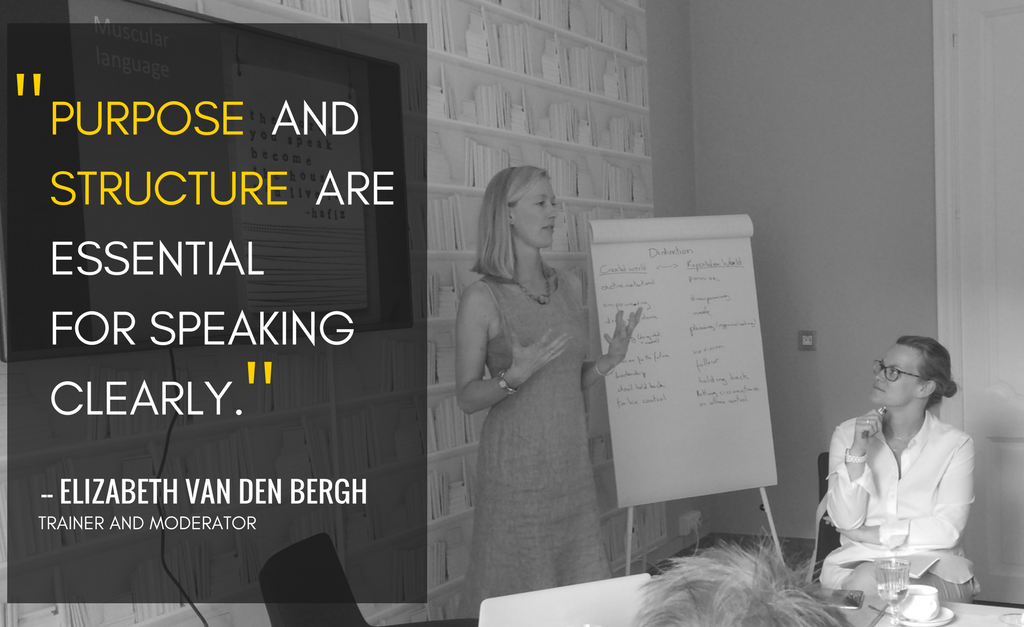Trainer Profile: Elizabeth Van Den Bergh

Hailing from Flanders, Elizabeth Van Den Bergh is a freelance communication consultant and trainer. At the age of 29 Elizabeth was named a deputy director for BIP Huis van het Gewest and two years later went on to lead her own PR team at Mostra Communications. While team leader she worked on projects such as the European Year Against Poverty and the International Year of Biodiversity. Elizabeth is fluent in Dutch, English, French and Italian. Awarded Competent Communicator at Toastmasters, she is also a trained public speaker.
Q: What advice would you give to someone nervous about public speaking?
A: There’s no quick and easy way to overcome nervousness for public speaking. My general advice is practice and patience. The more you are prepared, the better you will perform. A few tips for managing nervousness are:
- Collect positive energy from yourself: silence your inner critic and be nice to yourself. Tell yourself, “I can do this.” “People look forward to hearing me speak.” “I have something meaningful to say.” “It’s nice to get an opportunity to get my message across.” Remember that the audience likes you.
- Breathe and meditate: there’s enough research out there that tells us meditation can relax us, reduce our stress and even increase focus. So, before your presentation, take a few minutes to breathe deeply, meditate and let go of that nervous energy. We are often not aware of how shallow our breath becomes when we are nervous or stressed.
- Be in the moment: you’ve prepared, you know your material, and you’ve rehearsed. Now relax and don’t worry about the outcome. It is best to remain focused on the moment. Thinking about the future might distract you from your content.
- Redirect nervous energy: some people start moving from one foot to the other. This is not good, as it will distract your audience. Accept your nervous energy and turn it into a purposeful physical activity. E.g. controlled breathing, relevant hand gestures, consciously occupying the space.
“Take a few minutes to breathe deeply, meditate and let go of that nervous energy.”
Q: Is there any way to avoid PowerPoint when giving a presentation?
A: Absolutely, just eliminate your PowerPoint presentation. Participants like to take the content of your presentation home. You can replace your PowerPoint with a summary handout of your presentation or you can provide your audience with a link where they can download a digital summary (pdf, ebook, etc.).
But if you absolutely must use PowerPoint your slides should each have one image and one title, not more. Definitely, no bullet points or full text because this makes the audience pay attention more to the slides than to your presentation. Your message will be diluted the more you put on each slide. Text on slides also distracts you as a presenter because you will be tempted to read directly from it.
Q: What do you see as the biggest obstacle to speaking clearly?
A: In my opinion, that would be the lack of a purpose in your speech and a lack of structure. Purpose and structure are essential for speaking clearly. The first thing you should do when working on a presentation is identify point A and point B. Point A is where we are now and point B is where we want to be, your job as a presenter is to make a path between these two. Using this framework you can give a well-structured presentation of 5, 10, 15, or 20-minutes.
Q: How can you engage the audience with your presentation?
A: You have to be engaged yourself. Use ‘you’ and ‘your’ in your talk. Strive to highlight why and how the topic relates to your audience. Keeping good eye contact at all times is essential. I am a strong advocate of speakers making the best use of their voice and body language to properly engage with their audience. Additionally, you can engage with your audience by bringing a few props that illustrate your story and your main point.
Elizabeth teaches courses on Effective Public Speaking, Drafting a PR Plan and Presentation Skills for Clear Europe.





Add your comment